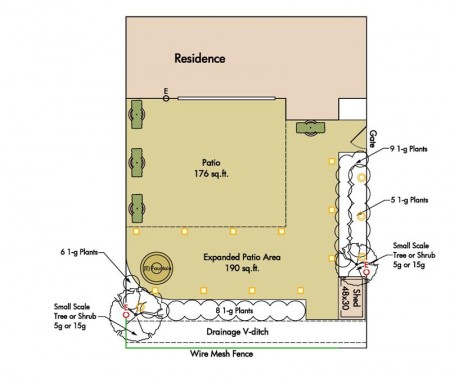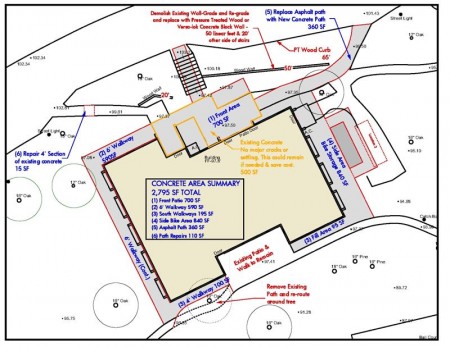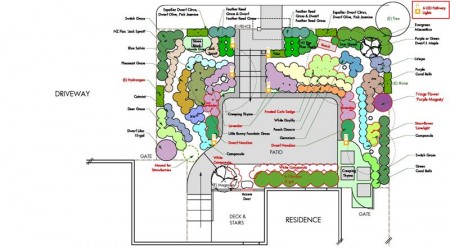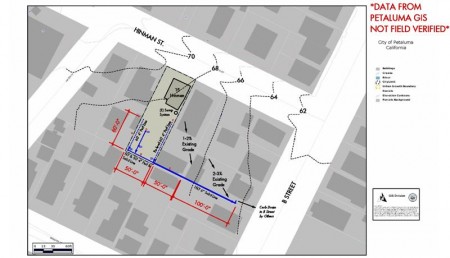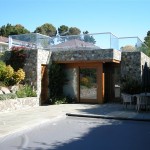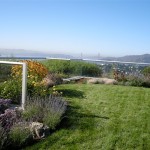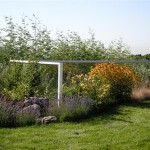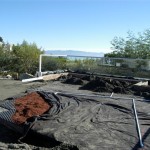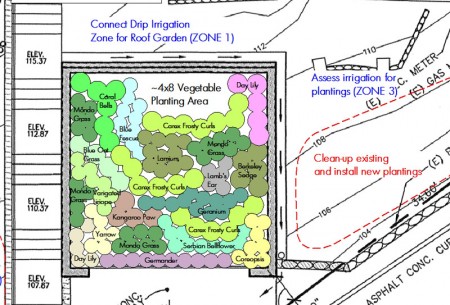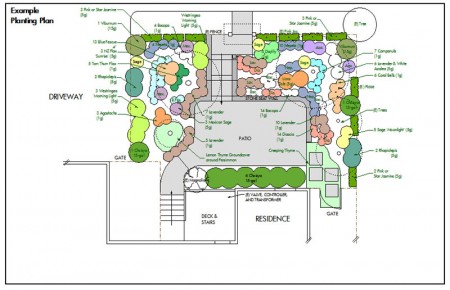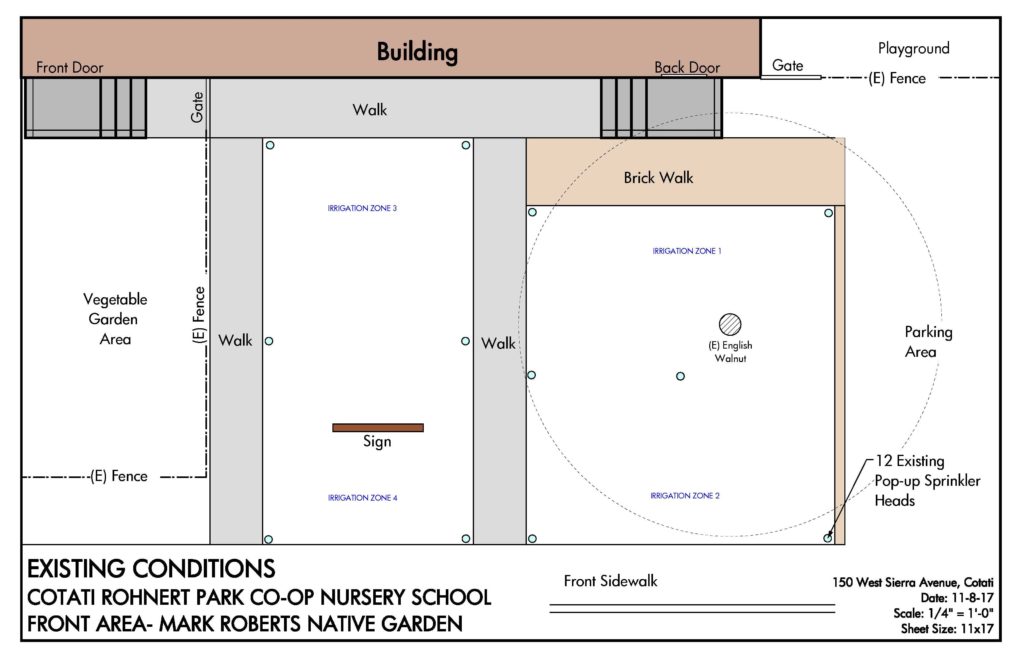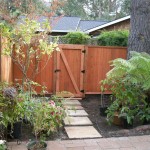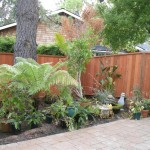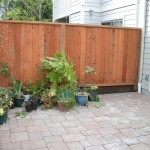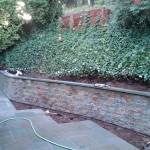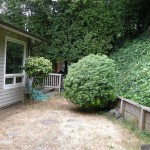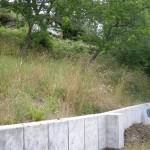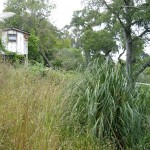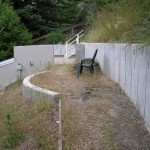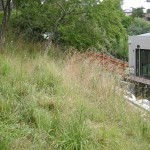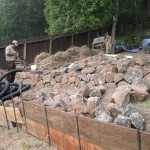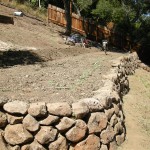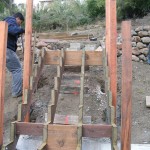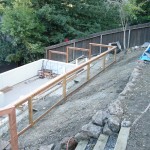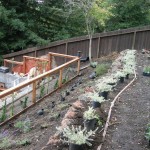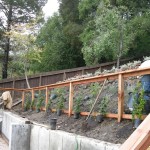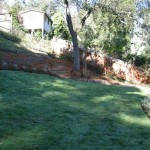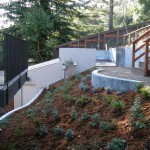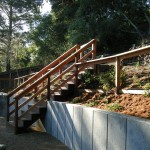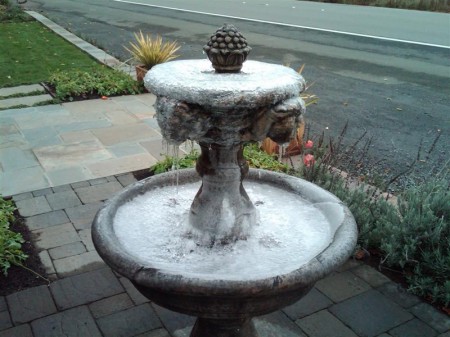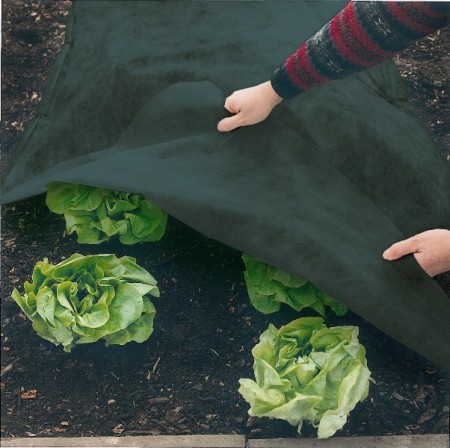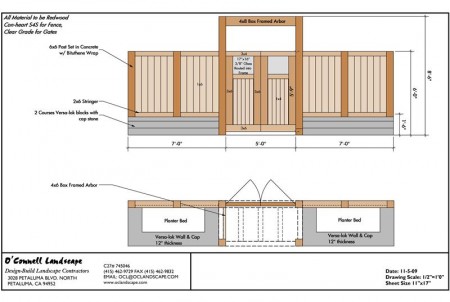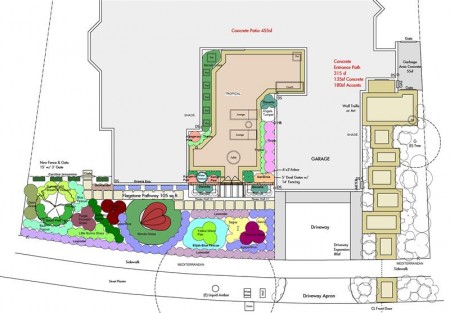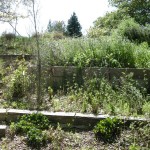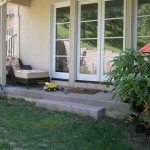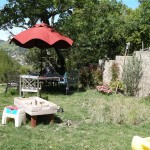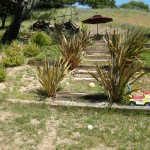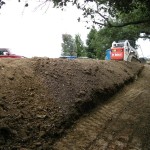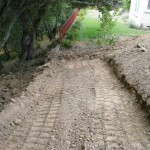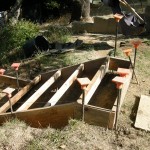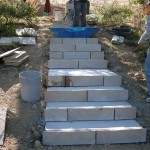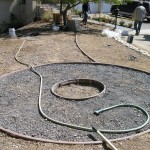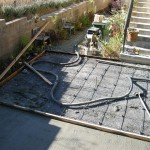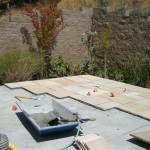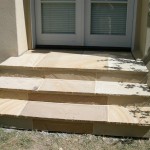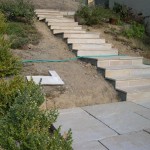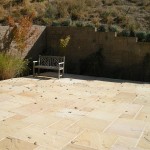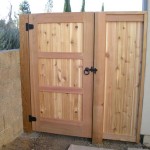We are working on an intimate back courtyard for this project in Novato. The new design expands the existing patio area, creating an outdoor room with integrated lighting, border plantings and fountain accent.
From the Drawing Board: San Rafael Commercial Project
Here is a plan view of a commercial project we are working on in San Rafael. The existing walkways and patio spaces around the building needed to be expanded to better suit the use patterns of the space, and to update and improve the aesthetics of the property. In this working drawing we are exploring options for path and patio layouts, with suggestions for possible budget saving measures.
Client Design Feedback – Corte Madera Project
We spent some time last night looking at the design and both said ‘wow…yes, now we’re getting somewhere!’ I will spend some more time processing today to prepare for tomorrow, but clearly we are close and you have us on the right track. Thanks for taking the time to ask us what we want and then giving some time to process your work before our meeting on Friday. Impressive, this really helps.Thank you, thank you!
Turned Earth Turns 400!
We are happy to announce Turned Earth’s 400th post! For the last 5 years we have been blogging about landscape issues and our ongoing work. We look forward to continued exploration, reflection, and provocation!
Bay Friendly- Apologizing to the Bay!
After attending a recent Marin County Bay Friendly Landscaper training session, I was so thoroughly impressed with the curriculum of the Bay Friendly Program and the quality of the speakers for the training session. The Bay Friendly Landscape guidelines form a compelling framework for sustainable landscape construction and maintenance. The one area where the training could be enhanced is with a greater emphasis on the history of the Bay and why Bay Friendly efforts are so important. For anyone who hasn’t seen the 4 part documentary “Saving the Bay,” which aired on KQED, it is an indispensible primer for the ecological, cultural, and social history of the San Francisco Bay. With this in mind, here is one landscaper’s Open Letter to the San Francisco Bay–
Dear Bay,
First off, we would just like to say we are sorry. Sorry for what we did to your forests and your streams. Sorry to the Grizzly, the Prong Horned Antelope, and the rest of your creatures that roamed long ago. Sorry to Salmon, that we canned by the bargeful. Sorry to the soil, that continues to slip away- only to wait another 10,000 years to form. Sorry to the great San Francisco Bay, estuary of estuaries, harbor of harbors.
We are sorry for the Baylands we filled, the marshes we drained, the streams and rivers we dammed and damned. Sorry for the pollution, the dumps, the garbage, the sewage. Sorry for our brake pads, that with every morning drive hit the road, and from the road flow to the Bay.
We say that we have changed. We say that we will be your friend, or at least that we will be Friendly. You have the benefit of time and experience. You wait with a watchful eye, marking the tides of moon and man.
Before we start on our new way, before we change our ways, let us acknowledge what we and our forefathers have done. See and acknowledge our mistakes, understand what we did wrong. Say we are sorry. Then we can embark on a better way.
After attending a recent Marin County Bay Friendly Landscaper training session, I was so thoroughly impressed with the curriculum of the Bay Friendly Program and the quality of the speakers. The Bay Friendly Landscape guidelines form a compelling framework for sustainable landscape construction and maintenance. The one area where the training could be enhanced is with a greater emphasis on the history of the Bay and why Bay Friendly efforts are so important. For anyone who hasn’t seen the 4 part documentary “Saving the Bay,” which aired on KQED, it is an indispensible primer for the ecological, cultural, and social history of the San Francisco Bay. With this in mind, here is one landscaper’s Open Letter to the San Francisco Bay–
Dear Bay,
First off, we would just like to say we are sorry. Sorry for what we did to your forests and your streams. Sorry to the Grizzly, the Prong Horned Antelope, and the rest of your creatures that roamed long ago. Sorry to Salmon, that we canned by the bargeful. Sorry to the soil, that continues to slip away- only to wait another 10,000 years to form. Sorry to the great San Francisco Bay, estuary of estuaries, harbor of harbors.
Sorry to the Baylands we filled, the marshes we drained, the streams and rivers we dammed and damned. Sorry for the pollution, the dumps, the garbage, the sewage. Sorry for our brake pads, that with every morning drive hit the road, and from the road flow to the Bay.
We say that we have changed. We say that we will be your friend, or at least that we will be Friendly. You have the benefit of time and experience. You wait with a watchful eye, marking the tides of moon and man.
Before we start on our new way, before we change our ways, let us acknowledge what we and our forefathers have done. See and acknowledge our mistakes, understand what we did wrong. Say we are sorry. Then we can embark on a better way.
From the Drawing Board: Petaluma Drainage Plan
Here is a drainage plan for a project we are bidding on in Petaluma. We used the great information at Petaluma GIS. The GIS interface is an online digital mapping application for the whole city of Petaluma that shows building locations, parcel boundaries and contours. This type of information is very helpful for projects like this when we are trying to estimate larger distances or distances across one or multiple parcels.
More on Living Roofs
There was another green roof article in this month’s NorthBay Biz, Up on the Roof, profiling the rooftop installation at the Academy of Sciences in San Francisco and a couple of projects in the North Bay that is worth a look.
After our earlier profile of the Watershapes article of the same name, a new rule for all those green industry columnists, you must title your articles something other than Up on the Roof.
The Other Side of the Table
I just spent the weekend meeting with vendors planning an upcoming event. What fun to be on the other side of the table during the consultation process and see the presentation and portfolio elements, which elements worked and which didn’t.
The Benefits of Green Roofs
For all those homeowners considering garden roofs, this rapidly developing specialty of landscape construction offers many sustainable benefits beyond just the wow factor of directly integrating garden spaces into residential architecture. The reduction in many of the ongoing heating, cooling, and insulation costs can help pay for the added cost of a green roof installation.
There was a great article in this month’s Watershapes Magazine on roof gardens. It’s a good primer and background on green roof types and the additional insulation and HVAC benefits to the insulation green roofs provide. (Catch it before the end of this month with the free on-line version)
Below is a gallery of a recent roof garden in Tiburon. We worked with Caletti Jungsten Construction and Pedersen Landscape Architecture to create a green roof for this unqiue pool house. See more in our Garden with a View Portfolio.
Estimate Etiquette- The Good and Bad
We have been bidding on a lot of projects lately. On some of those projects we win the bid, and on others we don’t, that’s the nature of the process. One interesting aspect of estimating process as a whole is what I call estimate etiquette. There are two parts to estimate etiquette, that of the contractor and that of the client. Like any aspects of courtesy these are subject to interpretation and depend on the context applied.
In general good etiquette by the contractor means being punctual for meetings, creating a detailed and pertinent estimate, and delivering it in a timely manner. Good etiquette by the client means respecting the time and effort bidding contractors put into estimates on their projects (which can be substantial), and updating clients as to the status of the project and their final decision moving forward.
For our estimates in general, these are done at no charge. They usually include an in personal on-site consultation and subsequent proposal presentation with the creation of a detailed estimate, and often supplementary materials information, specifications or conceptual designs. Client responses to the estimate can vary, but clients are usually either responsive and update the bidding contractors on the status of their project, or they fall off the face of the earth and do not only not update the contractor, but don’t respond to follow-ups via phone, email, carrier pigeon, etc.
Now, all this being said, we aren’t always perfect in the process of soliciting estimates for our projects with sub-contractors. The purpose of emphasizing good estimate etiquette is to help encourage some common courtesy and professionalism on both sides of the estimate process.
From the Drawing Board: Mill Valley & Corte Madera Plantings
Cotati Co-op Native Garden
This post gives an overview of a volunteer project at the Cotati Co-op Preschool-
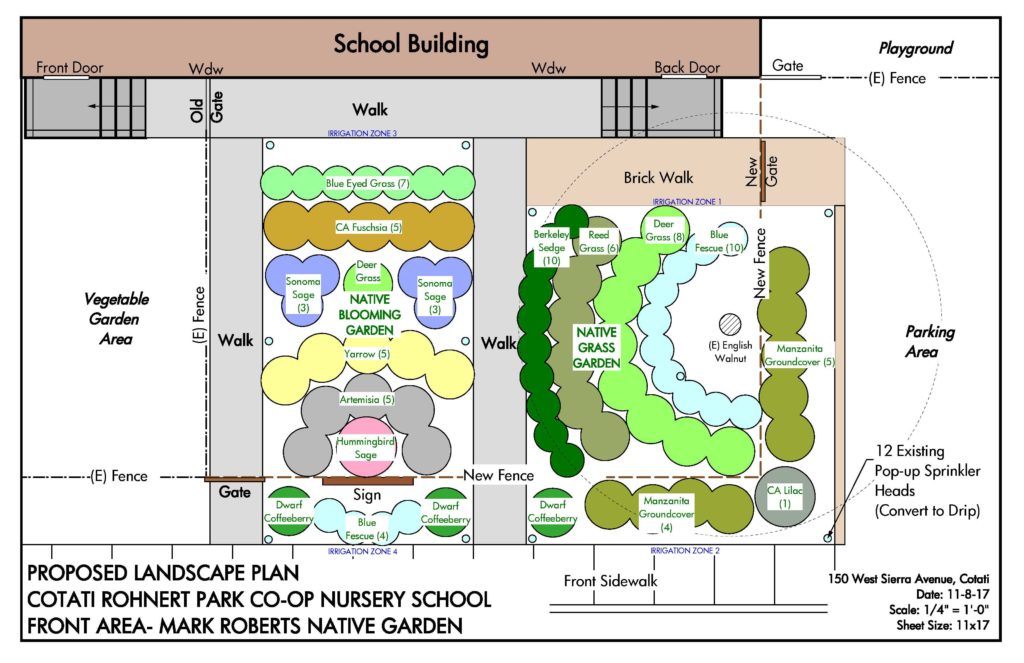
Work Scope: The work scope would involve two distinct phases. First would be new plantings, which would require the following steps-
- Remove existing plantings
- Cap and convert existing spray irrigation to drip irrigation
- Prep and grade new beds
- Plant new plantings with amended soil and slow release fertilizer
- Install new drip irrigation tubing and emitters to all newly installed plants
- Install a thick new layer of bark to finish the area, retain moisture, hide drip tubing, and reduce weeds
- Install botanical signs giving the common and latin names of newly installed plants.
Fencing Phase: The second phase would be to install a new extension of the perimeter fence to encompass both entry walkways from the front sidewalk, all the way to the parking area. This would have the benefit of enclosing the entire front of the school in a secure yard area and has been on Sherry’s wish list. As part of this work, the existing sign would need to be either relocated closer to the street, or replaced with a higher visibility sign that would face West Sierra Avenue.
Timing: Work would take place over winter break and be completed either sometime in December or January. I estimate 3-4 volunteer days being required for the planting phase, depending on the number of volunteers we have.
I look forward to discussing this more next week.
Michael O’Connell, O’Connell Landscape
(Zoe O’Connell, Butterflies)
Corte Madera Paver Project
Small gardens present unique opportunities and challenges. A smaller area means more richer detail can be incorporated into the design. At the same time small spaces need to be scaled appropriately. We transformed this small back yard into a usable extension of the lower living room of this condominium.
I was very pleased with the entire process. They helped me work with the condo board to get the project approved, were timely and responsive to my needs. And I love the finished project.
-Antoinette Nies, Corte Madera
Current Project- Belvedere
We are working on finishing up a new bluestone patio and stone veneered retaining wall for this project in Belvedere. There has been quite a transformation made to the front yard of this property that will provide new living and entertaining space.
Mill Valley Project Completed
One of the great things about working on residential landscape construction projects is it gives us the opportunity to work closely with homeowners to transform the yards and outdoor spaces. We just wrapped a hillside project installation in Mill Valley.
“The best contractor we have ever worked with! Always responsive and sensitive to budget issues. We would highly recommend O’Connell Landscape.”
-Kim Niquette, Mill Valley
Baby It’s Cold Outside
Cold Weather Preparation
As temperatures are going to get cold this week, there are a couple of easy steps you can take to help protect young or frost tender plants. If plants show frost damage you can spray Cloudcover, a polymer that provides 3-5 degrees of additional frost protection by forming a barrier on the leaves to help protect plants. Another good technique to help protect plants like citrus is to cover with sheets, or a frost blanket like this one from DuPont.
Local GIS Mapping Resources
Geographic information systems, GIS, are a really valuable tool for planning projects. Most GIS applications available from local counties and cities are web-based interactive mapping applications that allow you to search for a property parcel and view key information like property boundaries, topo contour lines, utilities, and aerial photos. All the information is scaled and most aerial photos available are orthogonally corrected (corrected to display to scale and not be distorted by the earth’s curvature).
So what’s the utility of GIS in landscape projects? The information can help with laying out site plans, confirming information on existing plans, siting trees, buildings and other key features. Most of the applications available online are intuitive and easy to use.
Marin County
Marin Map (all of Marin County)
Napa County
Napa County GIS
Sonoma County
Sonoma County PRMD Active Map (for areas in unincorporated Sonoma County)
City of Petaluma GIS Portal
City of Santa Rosa GIS
For More:
GIS Article from Wikipedia
Listing of GIS sites from around the State
From the Drawing Board: Entry Gate Detail
From the Drawing Board: San Rafael Planting Plan
Here is a planting design for a front yard in San Rafael that we are currently developing. The front yard design focuses on the front entrance gate and arbor. The yard is also shallow and to keep things in proper scale we focused on a deer resistant ornamental grasses and blooming perennials. The unique element all ready in place is a Hearts in San Francisco art piece that we used a focal point for the yard.
(Click image to see larger version)
A More Sustainable Thanksgiving
For more and more landscape projects a key consideration is the hot topic of sustainable best practices, environmental impact, and how best to green projects.
This drive to green everything from carpets to cars isn’t unique to the landscape industry, its one of the major driving forces in both new marketing campaigns and genuine efforts to reduce and mitigate environmental impacts.
As I attended a workshop and last month’s North Coast dinner meeting by Trathan Heckman of Daily Acts here in Petaluma, it became clear to me that this idea of sustainability is really all encompassing. Trathan’s work and presentations on gray water systems, local agriculture, and community and back yard gardens brought this home. Our choices make a difference- from the decisions we make on things like irrigation and plantings, to what we eat and where it’s grown.
As Thanksgiving approaches and we give thanks, we can also consider the sustainability of the meal itself. We can support local economies and local agriculture, and also sustainable agricultural practices. Consider instead of a typical mass produced supermarket turkey for example, an alternative Heritage Turkey, bred in a free range environment, with reduced environmental impacts (or for even less enviornmental impact, skip the turkey). Good Shepherd Poultry and a growing number of other small turkey farmers are working to re-introduce heritage birds and raise turkeys more sustainably.
Novato Completed Project
This project in Novato was a multi-phase project that grew from an initial focus on one section of the yard, to a comprehensive new grouping of flagstone patios, steps, and plantings.
We used a Dusty Way Indian Sandstone to tie together the front entry, side landings and steps, and a large rear patio.
“We had such a good experience we increased the work 4 fold. Workers turned up every day and left the site clean and safe. I would recommend O’Connell for anyone wanting a top quality job with excellent project management” -Juliet, Novato
From Freeways to Boulevards
After watching Saving the Bay, and its great history of poor planning, development, and conservation, I was looking at different videos of the Bay Area and its planning history. Here is a great video on the history of the much maligned Embarcadero Freeway and its ultimate transformation into the Bay waterfront of today.
Saving the Bay
If you haven’t had a chance to see the excellent four part documentary on KQED channel 9, Saving the Bay, it is a great history of the amazing natural feat of San Francisco Bay and it’s trials and tribulations. This program is a thought provoking piece for all residents of the Bay Area. The Bay and its history is also important to take into consideration when doing landscape projects, and how landscape work effects the Bay (water use, drainage, sediment run-off, herbicides, pesticides, and wildlife effects).



Changing to WordPress
We just changed our blog software from Movable Type to WordPress. What a difference! WordPress is faster, more user friendly, open source and popular- all great features for a blog platform. For the non-professional web developer Movable Type wasn’t the right fit for us.
The best part of Wordpess is the photo management. Unlike Movable Type you can upload multiple images and organize them in galleries.
A Greener Lawn & Lawn Mower
As part of our new demonstration garden at our office here in Petaluma we installed a native turfgrass lawn with subsurface irrigation. This represents a leap forward in water efficiency and sustainability, but now the question is, how do we mow it?
We wanted a lawn mower that would be cost effective, and we just needed it for office use. Getting the administrators out to mow the front lawn is similar to the idea of the company CEO using the copy machine from time to time.
After searching on Amazon.com and with help of user reviews we settled on 24 volt battery powered mower by Earthwise. So far we have been impressed. Power is good, and the deck height accommodates the 2-6″ recommended mowing height for the Native Bentgrass lawn. Plus the mower requires no gas, and doesn’t have the polluting emissions of a small engine lawn mower. The only problem we found in our search was that some reviewers complained about the possibility of damaging the battery if left to charge too long.
While it wouldn’t work for a commercial application this seems like an ideal mower for a homeowner with a small to mid-size lawn.

Post Referenced in Lawn and Landscape Magazine
Our post on our pricing and the pricing of our vendors was referenced in a story in this month’s Lawn and Landscape magazine.
Just goes to show that these type of pricing issues are critical to being profitable in a difficult economy.
In other blog related items, we just rebuilt our blog, combining an older platform of the blog with a new rebuilt interface. This means that over 350 posts from 4 years of Turned Earth can be found in one place and searched. Enjoy!
Our Demonstration Garden
Come visit our demonstration garden at our Petaluma office!
The garden is still under construction and features constant additions. Below are a few of the landscape installations we are featuring now.
–Smart irrigation Controller: with easy to use Solar Sync sensor that monitors and changes watering based on weather conditions
-Water Features: Self contained and in ground water feature samples
-Materials: Flagstone pathways, redwood fences and arbors, deer fences, decomposed granite and more
Simple Graywater Systems for Landscapes
I attended a demonstration in Petaluma by Daily Acts, a Sonoma County non-profit, of their graywater system, which was the first permitted residential system in Sonoma County. The workshop was given by Trathen Heckman of Daily Acts and Brock Dolman of the Occidental Arts and Ecology Center Water Institute. Both have been involved with graywater legislation that it is making its way through the state legislature and regulations by Sonoma County.
The simplest graywater system is a laundry to landscape system, which recycles graywater from the washing machine out into the landscape.
This system is easy to install with a few simple parts including a 3 way diverter valve, vacuum breaker and 1″ distribution laterals out into the landscape. In Sonoma County it can all be done with a simple plumbing permit, and without the need for more elaborate design, permitting and plumbing of a more extensive graywater system.
For More:
The Daily Acts website has a wealth of resources on graywater and a host of other projects as does the OAEC Water Institute website.
Greywater Guerrillas– has great information, workshops and more
Oasisdesign.net– more graywater design information
Video on Trathen’s Graywater installation in Petaluma:
Petaluma Lawn Renovation
We are working on a project in Petaluma for a lawn renovation and back yard landscaping. The old lawn had broken sprinklers, hadn’t been maintained, and was too big for the back yard. We developed a design to reduce the lawn size, install more efficient spray heads, and incorporate a seating area and low maintenance, low water use plantings for half the lawn area.

